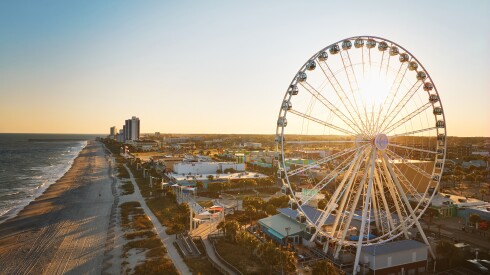From the rugged sea stacks of the Pacific Northwest to the white sands of Florida, the United States offers an incredible range of beach experiences. Some sit at the edge of resort towns while others on barrier islands, shaped by shifting tides and the rhythm of local life.
Whether it’s a glimpse of wild horses or a coastal trail shaded by palms, each of these nine beaches offers more than a place to swim—they’re worth planning an entire trip around.
Waikīkī Beach, Hawai‘i
Since the rise of surf tourism in the early 20th century, this stretch of Honolulu shoreline has been one of the most famous beaches in the world. Today, it still delivers on the oceanfront energy that first put it on the map. Gentle waves make it ideal for first-time surfers, while the long curve of sand against brilliant turquoise water is perfect for a morning walk or sunset swim. A short stroll inland reveals shaved ice spots, vintage surf shops, and one of the liveliest beachfront scenes in Hawai‘i.

At Cannon Beach, visitors can view basalt formations.
Photo by Kimberly Shavender/Shutterstock
Cannon Beach, Oregon
Cannon Beach feels more like an atmospheric film than a typical beach day destination. Framed by jagged cliffs and windswept pines, it’s best known for Haystack Rock, a towering monolith that rises from the surf like a sculpture. Fog often rolls in before noon, lending the place an ethereal, slightly surreal quality. Tide pools teem with sea stars and anemones at low tide—if you’re lucky, you might spot tufted puffins nesting nearby.
Coopers Beach, New York
Set at the edge of one of Long Island’s most historic and high-end towns, Coopers Beach has long been a summer favorite for New Yorkers escaping the city. The shore is wide and gently sloping, backed by grass-covered dunes and glimpses of Gilded Age mansions. Unlike many public beaches, there’s an old-school elegance here, complete with a snack bar that serves lobster rolls. Just off the sand, antique shops and farm stands along the streets of Southampton give it a small-town feel.

The Quileute Tribe has lived in this part of Washington for thousands of years.
Photo by Max Bender
La Push Beach (First Beach), Washington
First Beach, situated just outside Olympic National Park on the Quileute Indian Reservation, is renowned for its mist-shrouded sea stacks. Driftwood logs pile up along the shore like a sculptural installation, and gray whales are sometimes visible from land in the spring. Visitors can explore nearby Rialto Beach and Second Beach on foot, although First Beach is the only one easily accessible by car.

Crystal Cove State Park is located in Orange County, California.
Photo by Alan Budman/Shutterstock
Crystal Cove State Park, California
Few Southern California beaches feel as unspoiled as Crystal Cove. This protected stretch of coastline between Newport and Laguna Beach has 3.2 miles of sand, tide pools, and hiking trails, plus a district of restored 1930s beach cottages that visitors can rent. Surfers ride the swells near Reef Point, while more casual visitors explore the shallow coves and rocky outcrops further north. Inland, trails wind through chaparral-covered hills that bloom with wildflowers in spring.

Wailea means “the water of Lea”; she is the goddess of canoe builders in Hawaiian mythology.
Photo by GrantSmithCamera/Shutterstock
Wailea Beach, Hawai’i
Set between lava outcroppings and luxury resorts, Wailea Beach offers a polished slice of Maui that still manages to feel serene. The golden sand is soft and wide, with gentle waves that make it a favorite for swimmers and paddleboarders. Palm trees line the shore, and a paved oceanfront trail connects Wailea to a series of smaller beaches and coves. Early risers are rewarded with peaceful views and the occasional sighting of a sea turtle near the rocky edges.

There are an estimated 300 horses on Assateague Island.
Photo by Stephen Bonk/Shutterstock
Assateague Island National Seashore, Maryland/Virginia
The 37-mile-long Assateague Island straddles Maryland and Virginia and is famous for the wild horses that roam freely through the dunes and marshes. But it’s not just about the ponies—the beach itself is wide and uncrowded, with rolling Atlantic surf and space to camp under the stars. Rangers offer guided walks through the salt marshes, and migratory birds fill the skies in spring and fall. Bring bug spray (especially in summer), and be prepared to share your view with the horses.
Beachwalker Park, South Carolina
The sand at Kiawah Island’s Beachwalker Park is hard packed, ideal for long walks or beach bike rides at low tide. Behind the dunes, maritime forests and salt marshes provide a backdrop that feels wilder than you’d expect for a place only 45 minutes from Charleston. Lifeguards, restrooms, and a boardwalk make it accessible for families, while kayakers launch into nearby inlets to explore the island’s quieter corners. Even during peak season, it’s easy to find a stretch of sand to call your own.

Siesta Beach’s quartz comes from the Appalachian Mountains, brought down rivers to the Gulf Coast over millions of years.
Photo by Felix Mizioznikov/Shutterstock
Siesta Beach, Florida
Just off the coast of Sarasota, Siesta Beach is renowned for its ultra-fine, white sand that remains cool even on the hottest summer days. Composed almost entirely of quartz, the sand feels soft underfoot and reflects the Gulf’s pastel-hued sunsets in the evening. The beach is wide enough to feel spacious even during high season, with volleyball courts, picnic areas, and a gentle slope into calm, swimmable waters. On Sunday evenings, drummers gather near the main pavilion to celebrate sunset with an informal circle that draws both locals and visitors.











